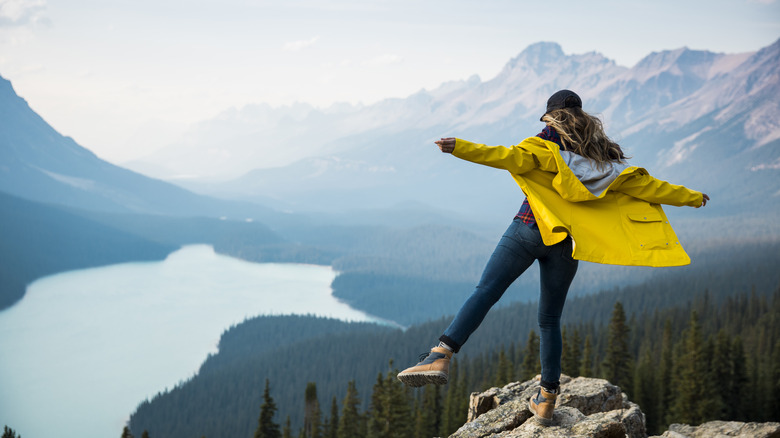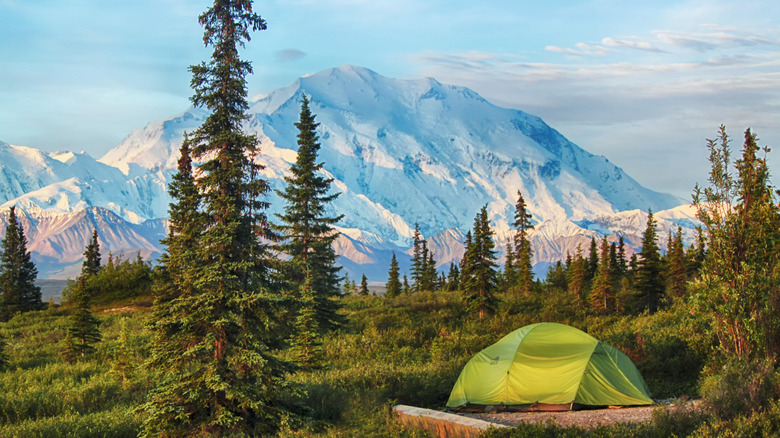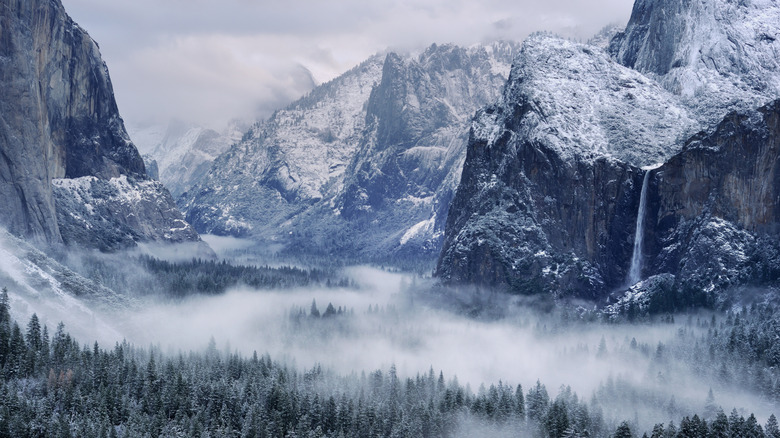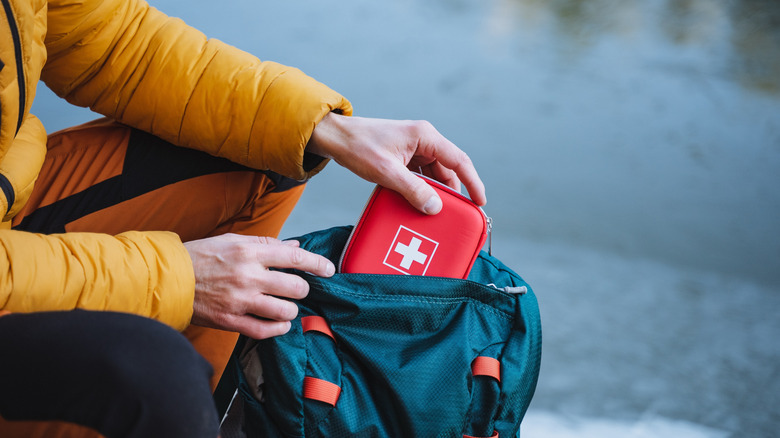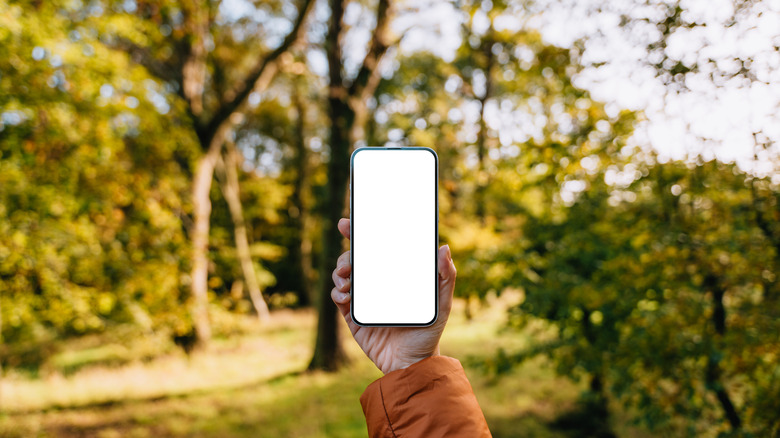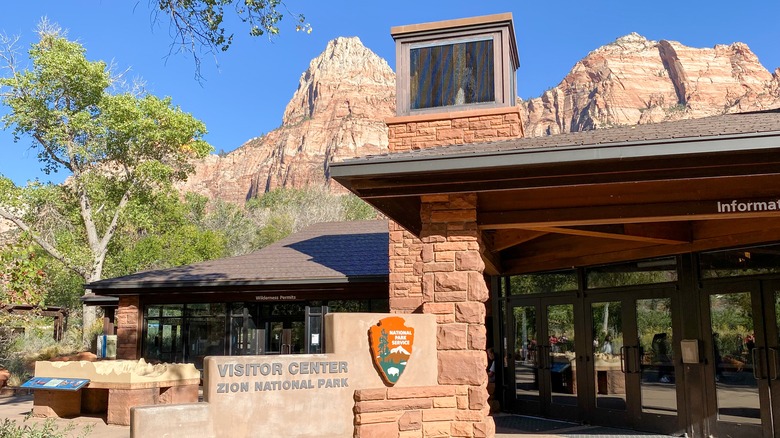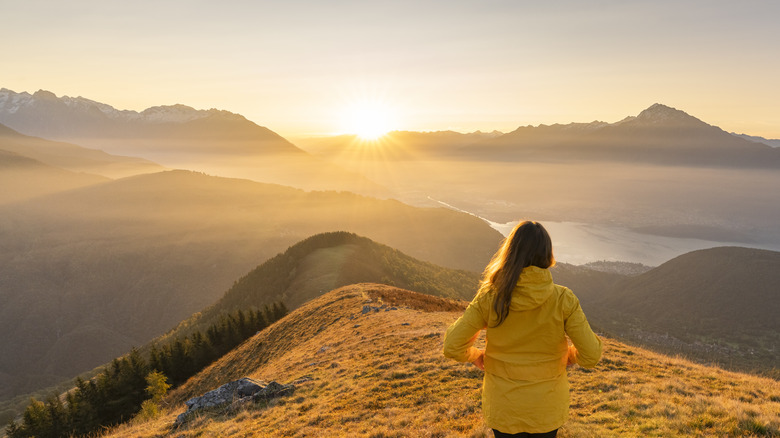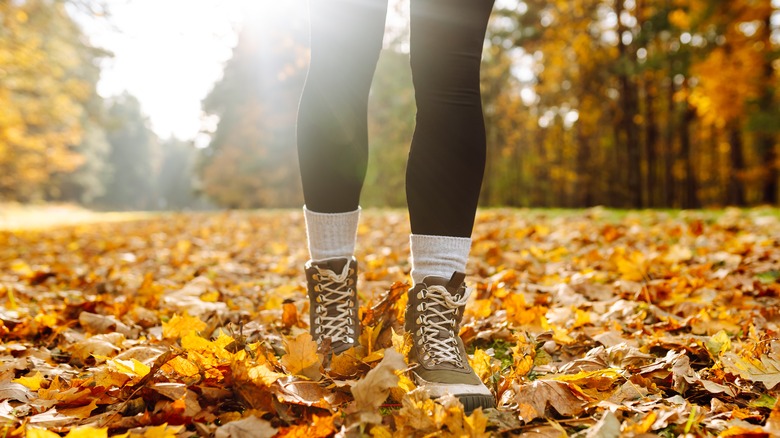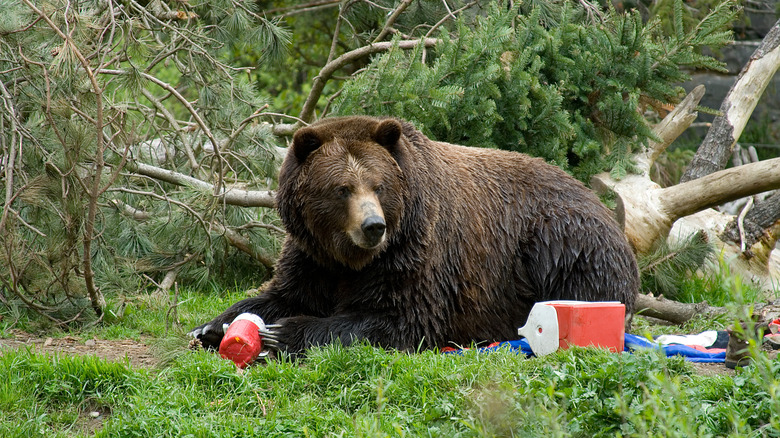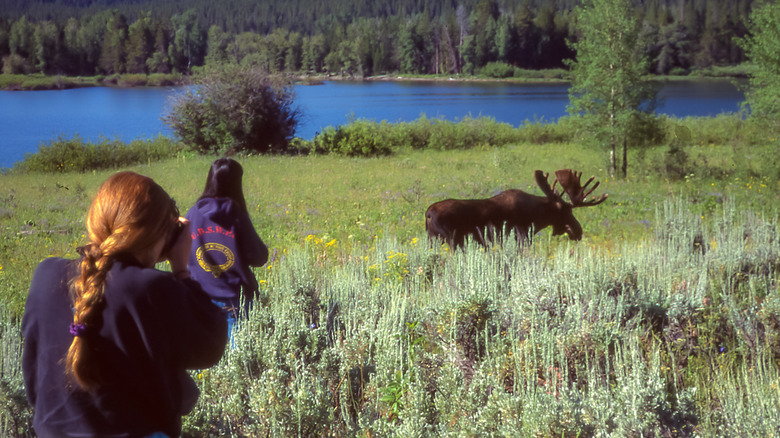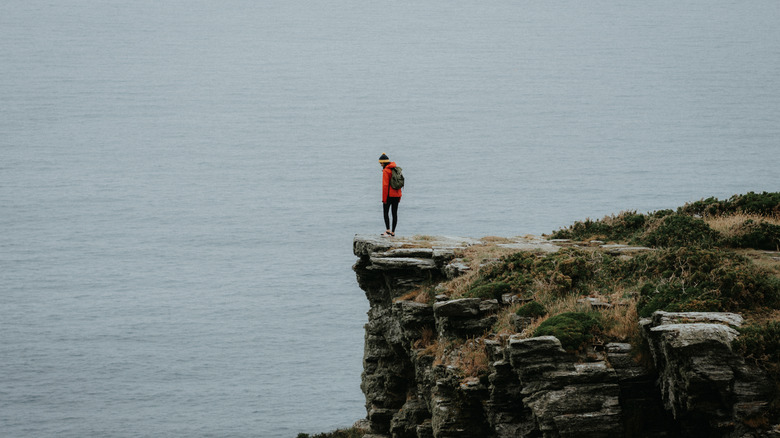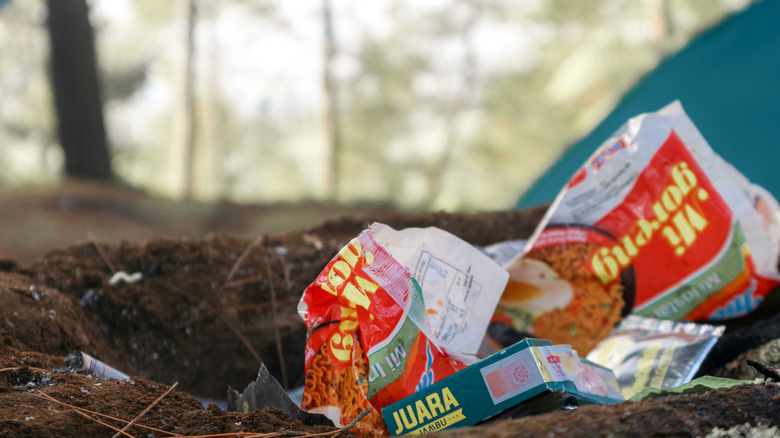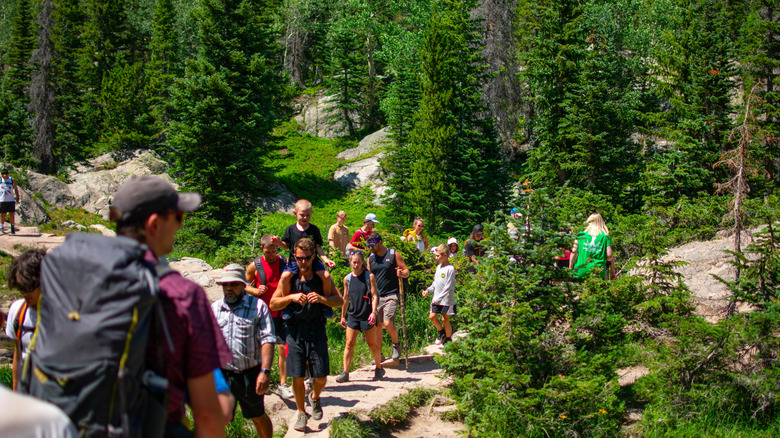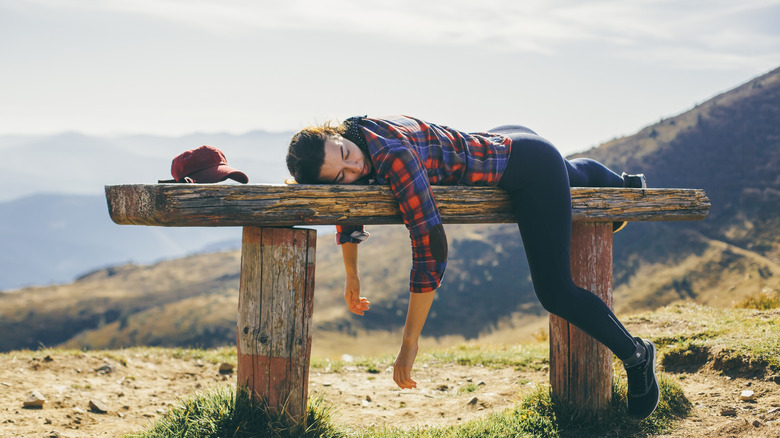The Most Common Mistakes First-Timers Make While Visiting A National Park
Every year millions of eager visitors flock to the 433 national parks across the United States. These people can't wait to explore the great outdoors at its peak, but many of them underestimate the task at hand. Unlike many travel experiences, wandering around a national park requires quite a bit of targeted knowledge because making a single mistake out in the wild can be very dangerous.
Think about it. A blunder out in the wide wilderness could leave you stranded, starving, injured, or even dead. While travelers do need to be a little more cautious when they're getting to know a national park, this reality shouldn't scare you away from visiting them because they are truly incredible. All you have to do is read through these common errors that people often make when they go to a national park for the first time and keep them in mind for your trip.
Not booking a reservation or permit in advance
Since national parks are a part of nature, many first-timers wrongly assume that they can simply show up to one without booking anything beforehand. This presumption could result in you being turned away by park staff. Particularly, if you're planning to check out a very popular national park such as Yellowstone National Park or Grand Canyon National Park.
There is limited space at even the largest national parks and lots of folks are eager to spend time there, so you often need to secure yourself a spot before you arrive. While there are many national parks that are always free to enter, even these places typically require visitors to book a reservation or get a camping permit in advance during the high season. For instance, Arches National Park, Glacier National Park, and Yosemite National Park all require reservations during their most heavily visited points of the year.
Prepare ahead of time and check the official website of the park you're visiting to determine whether you will need a reservation. If you plan on visiting more than one U.S. national park soon, it can be more savvy to grab yourself an "America the Beautiful—National Parks and Federal Recreational Lands Pass." It costs $80 and gives you access to all the country's national parks with their amenities for one year.
Under Preparing for the weather
Your experience at a national park will look completely different in the height of summer than it would in the dead of winter. The considerations you need to take will change dramatically depending on what time of year it is and where your destination is located. It's possible to have a successful outdoor adventure whether it's freezing cold or brutally hot as long as you're properly prepared.
If you want to see a real winter wonderland firsthand, you should pack multiple layers of clothes to wear every day, high-quality boots with spikes, thick socks, a strategically packed first aid kit, and a thermos for hot drinks to warm yourself up. On the other hand, explorers who want to escape the cold at the warmest national parks to visit in winter will need to take other precautions. In this case, you'll need things like light clothing, a fully stocked water backpack, sunscreen, bug spray, and sunglasses. Don't forget that visiting national parks in the summer can be just as dangerous as it is in the winter.
The weather is a crucial aspect of visiting national parks because under-preparation can very easily turn deadly. The Independent reported in 2022 that a couple embarking on a long hike through Zion National Park discovered this firsthand when temperatures dropped dangerously low and they weren't expecting it. They quickly started showing signs of hypothermia and the husband went to get help, but unfortunately by the time emergency services arrived his wife had already passed.
Failing to pack the right gear and supplies
Your backpack and its contents are your lifeline when you're visiting a national park. While everyone hopes that their trip into the wilderness will be problem-free, this isn't always the case and you need to be equipped for any situation. Missing just one essential item from your packing list can turn a fun day outside into a nightmare. Your packing list will vary significantly based on which national park you're visiting and when, but there are a few key items you should always pack.
The first big necessity for any national park trip is plenty of water to keep you hydrated and a few solid snacks. You never know if you'll have access to these things while you're at the mercy of Mother Nature and being without them could become a crisis very fast. Another thing you should always have in your bag when you're going to a national park is a first aid kit.
Your first aid kit should be well-stocked with things like tweezers, bandages, burn cream, headache medicine, an antihistamine, and any other medical devices you may personally need like an EpiPen or an inhaler. It's also a smart idea to carry a map of the park you're exploring to help you find your way around when your devices lose service. While you should be ready with everything you need in your bag, try to avoid over-packing at the same time because it can be a drain to carry around a bunch of heavy, unnecessary things.
Attempting to use cell service for directions
In an era when basically everyone is reliant on their cell phones, it's understandable why so many people would assume that they could count on them even in a national park. It can be a big shock when they get into the woods and discover their device has absolutely no service. Since national parks are usually pretty remote it is unlikely you'll find a powerful signal anywhere except maybe near the visitor's center if they offer WiFi. A user explained on Quora, "In the United States, few National Parks have cell towers because it would violate the charter and mission of the National Park system. Specifically, the national park service is to preserve, along with plant life and animal life, the scenic beauty of the national park in their charge. Cell towers distract from the natural beauty, so parks don't erect them."
It's best to assume that you won't be able to use your phone in most national parks period. That means you will be unable to navigate around the park using your GPS, call anyone, or do anything else that requires service. This can actually be a blessing in disguise because it gives visitors the opportunity to truly immerse themselves in the vast nature around them without the distraction of technology. Just make sure you let a trusted friend where you're headed and dust off your GPS-free directional skills.
Skipping out on the visitor center
On their first trip to a national park, most people just want to jump into the action and forget all about the visitor's center. They assume that the building is just a glorified bathroom, but this couldn't be further from the truth. While it's true that a national park's visitor center will typically have restrooms to use, there is much more to them than just that. As one Reddit user shared in r/nationalparks "I liked the visitor center at Joshua Tree because of the really great labeled garden out front. It was awesome to see the diversity of plants that exist in the desert and the labels helped me ID them myself later when I saw them in the park."
Visitor centers are the experts on their specific parks. They can provide you with the most updated information for the time you're there and are happy to directly answer any looming questions you may have before going in. The offerings at each one differ slightly, but in general, you can also expect things like souvenirs available for purchase, park maps, WiFi, trash cans, facilities to refill your water bottles, and sometimes even exhibits that are relevant to the park.
Starting your day off too late
Even over a single day, a national park can change drastically. The crowds, weather, and overall conditions will all vary depending on what time you start your day. It is heavily recommended by experienced national park visitors to get out there as early as possible. Some even suggest arriving with the sunrise at 6 a.m. Just make sure that the park permits visitors at such an early hour and you can bear it.
The more heavily visited the park is, the earlier you should try to arrive — especially on a weekend when more people will want to spend their free time outdoors. One person in r/Yosemite explained it well by stating, "Earlier the better, simple as that. The longer you guys wait, the more risk of parking filling up." During the summer, getting to a national park early also gives you plenty of time to traverse the area before it gets to the hottest point of the day from 2 p.m. to 4 p.m.
Going off the beaten path on your own
Diverging off a national park's marked trails is a bad idea for more reasons than one. Firstly, there's the obvious chance of getting lost out there. The largest U.S. national park spans over 13 million acres, which is a lot of room to get turned around. In that much space, there is a scarily high chance of never being found again if you're not on a designated path that other visitors traverse.
A study by Smokey Mountains as reported by People found the vast majority of hikers who get lost in national parks do so while they're walking off the trail. Besides the fact that veering off the established paths can be life-threatening for you, this action can be just as detrimental to the environment of the national park itself. According to the National Park Service, stepping off the trail can cause harm to the park's delicate flora or even kill it altogether. Visitors won't be able to appreciate these natural wonders for decades to come if all the beautiful plant life is destroyed by careless visitors.
Ignoring wildlife precautions like proper food storage
When you enter a national park, you're setting foot into the home of many different animal species. Being immersed in a place that's crawling with so much wildlife means that you must take careful precautions to stay safe. After all, there are certain national parks where you are almost guaranteed to spot a bear.
The easiest way to keep yourself and your campsite secure from all the hungry animals hiding in the forest is properly disposing of your trash in containers that creatures like bears can't get into. This will save your belongings from being destroyed by a rummaging animal and it could also prevent them from choking on your garbage. Campers who are spending the night in a national park should also be cautious with their food storage by hanging everything edible in a canister away from where you'll be sleeping. Just packing all your food away in a cooler isn't enough because bears are intelligent enough to break their way in.
Encroaching on an animal's space
Being respectful of the wildlife is a cardinal rule of visiting a national park. One of the most upsetting tourist mistakes people make at a national park like Yellowstone is getting too close to these critters. A previous scientist for the National Park Service told USA Today, "They start to learn that people aren't the threat and so then they stop reacting, and so this then causes a feedback loop where people think, 'Oh, this animal's letting me get up close. It's kind of tame. It's OK. It's safe for me to get close.'" Even animals that seem friendly enough should never be approached too closely because it's risky for everyone involved.
At Yellowstone alone, 44 people have been hurt in bear encounters since 1979. Another 25 individuals were attacked by bison at the park from 2000 to 2015. While attacks like these are quite rare, encroaching on an animal's space is a surefire way to raise the chances of it happening.
The National Park Service warns that getting too close to the animals at a national park can also lead to diseases being passed between wildlife and humans. With all that being said, watching diverse wildlife in its natural habitat can be an exhilarating part of your national park trip as long as it is done from a proper distance. You should stay at least 25 yards away from traditionally harmless wildlife and a bare minimum of 100 yards clear of predatory animals such as bears.
Getting too close to an edge
Many travelers want to capture a photograph of themselves standing bravely at the edge of a mountaintop when they visit a national park, but this is actually one of the most dangerous places ever to take a selfie. All it takes is one wrong move to go tumbling over the edge of a cliff. This tragically happened to a man from Hong Kong in 2019. BBC revealed that he was attempting to take a photo of himself at Grand Canyon National Park before he slipped and fell 1,000 feet down to his death.
This isn't just a one-off incident either, it's a fairly common occurrence. Approximately two to three people fall to their deaths like this annually at just this one national park alone. One analysis by Panish Law found that 478 people passed away from falling at a national park from 2007 to 2024. That's why national park visitors should never cross safety fences for any reason and must stay far away from the edges even if there are no clear boundaries established.
Leaving garbage and other traces behind
Visitors are expected to do their part in protecting national parks. The best way to accomplish this is by following a philosophy known as 'Leave No Trace'. The goal is to allow people to experience nature without negatively impacting the environment. Many newbies to the national park scene think that this means you should simply clean up after yourself and while that is accurate, there is much more that goes into leaving no trace.
The National Park Service instructs that visitors must be very careful with their campfires and refrain from taking anything from the park, even something as seemingly insignificant as a rock. It's also important not to change the environment in any way for your campsite by digging or building. While these actions might seem minimal when it's just you doing them, imagine thousands of other people also doing these things. It wouldn't take very long at all for a beloved national park to be wrecked.
Assuming there won't be crowds
Oftentimes travelers envision their first trip to a national park as perfectly serene. Unfortunately, that isn't always the case because lots of people want the opportunity to soak up nature in national parks. Places like Glacier National Park can receive over three million visitors annually. Bumping shoulders with hundreds to thousands of other hikers can definitely put a damper on the day, but it's unavoidable at certain points of the year.
The best way to steer clear of all these overwhelming crowds is by checking out national parks during their off-season. These are the months when a destination receives the least amount of visitors and it differs from park to park. If you're adamant about visiting during the more popular times of the year, the best way to avoid national park crowds during peak season is to be flexible with your schedule and itinerary. You can narrowly avoid the masses by exploring on a weekday or heading to the lesser-visited sections of a park.
Overestimating your physical fitness or pushing yourself too far
Out in the unforgiving expanse of nature, pushing your body too far is a dangerous game. It's easy to overestimate your abilities during your first trip to a national park as well. Many people miscalculate their endurance between the elevation changes, rough terrain, and intense weather. Unfortunately, this could end up with you getting painful muscle fatigue, cramps, or even fainting if you're underprepared for the exertion.
The results of overestimating your physical fitness can be much more dire than just feeling sore, too. The Daily Beast reported in 2023 that a 64-year-old woman collapsed along a three-mile trail in Big Bend National Park that's known for having very little shade and sadly she could not be revived afterward. Before your first trip to a national park, realistically evaluate your capabilities and only embark on excursions that match your experience level.
